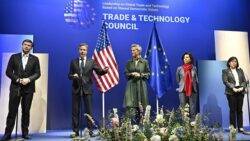Differing opinions on what to do about China is becoming a key issue between the two allies.
The European Union and United States say they are unified in their approach to dealing with China, despite significant differences behind the scenes.
Washington has long been calling for a reluctant Brussels to take a tougher stance on Beijing, including calling it out on its alleged anti-competitive and economically coercive behaviour.
Both sides, however, presented a united front when they met in Lule? in Sweden’s Arctic Circle on Wednesday for the fourth Trade and Technology Council between them, aimed at boosting cooperation.
“We see very much eye-to-eye on a number of these issues, for instance, when it comes to coercion we have the anti-coercion instrument,” the European Commissioner for Competition, Margrethe Vestager, told reporters during a press conference.
“This, of course, is part of the strategy, as well as export controls, so that we can indeed identify risks, deal with them and then trade for the rest of it.”
“Our interests are aligned as it relates to China,” United States Secretary of Commerce, Gina Raimondo, added.
The reality is quite different though. Within the bloc, opinions on what to do about China vary greatly.
European Commission President Ursula von der Leyen has recently taken a more hawkish stance on the matter, falling more into line with the tougher view from Washington.
But some countries, including France, do not necessarily agree with this approach, particularly when it comes to cutting or reducing trade ties, as Niclas Poitiers, a research fellow at Bruegel, explained.
“At this point in time, there’s still a reluctance to take on the same US line,” Poitiers said in an interview with Euronews.
“European countries have export and import interests in China. Many European companies make a lot of money in China, but at the same time, there is a recognition in Europe that China will continue to be a big player in the global system, and many other countries look at how we behave towards China and they might perceive what the G7 does with the EU investors against China as an attempt to keep an emerging market down.
“And given that the share of the EU and US and global trade will continue to decline, we need to find a different way of managing this, and this US kind of confrontational course of action is seen as problematic for that reason.”
Despite differences on China, there are things that both sides agree on.
A new joint voluntary code of conduct for artificial intelligence was announced as in the works on Wednesday, with a desire to ensure that the new technology develops in a safe and effective way.
“We have different legislative procedures. It will take two, three years at best before that would come into effect and we are talking about a technological acceleration that is beyond belief,” Vestager said.
“Here we think it is really important that citizens can see that democracies can deliver.”
Beijing has not yet been factored into this equation, with Brussels and Washington calling, for now, on all democractic countries to sign up to the code of conduct.
There is also a commitment from the two sides to putting sustainability at the core of trade relations, as well as harmonisation on green issues, including an agreement reached on a common standard for the recharging of heavy-duty electric vehicles.
Going forward though, how to deal with China will become an unavoidably larger topic.
For now, it is being pushed to the sidelines by an EU that still does not collectively know where it stands on the issue.





